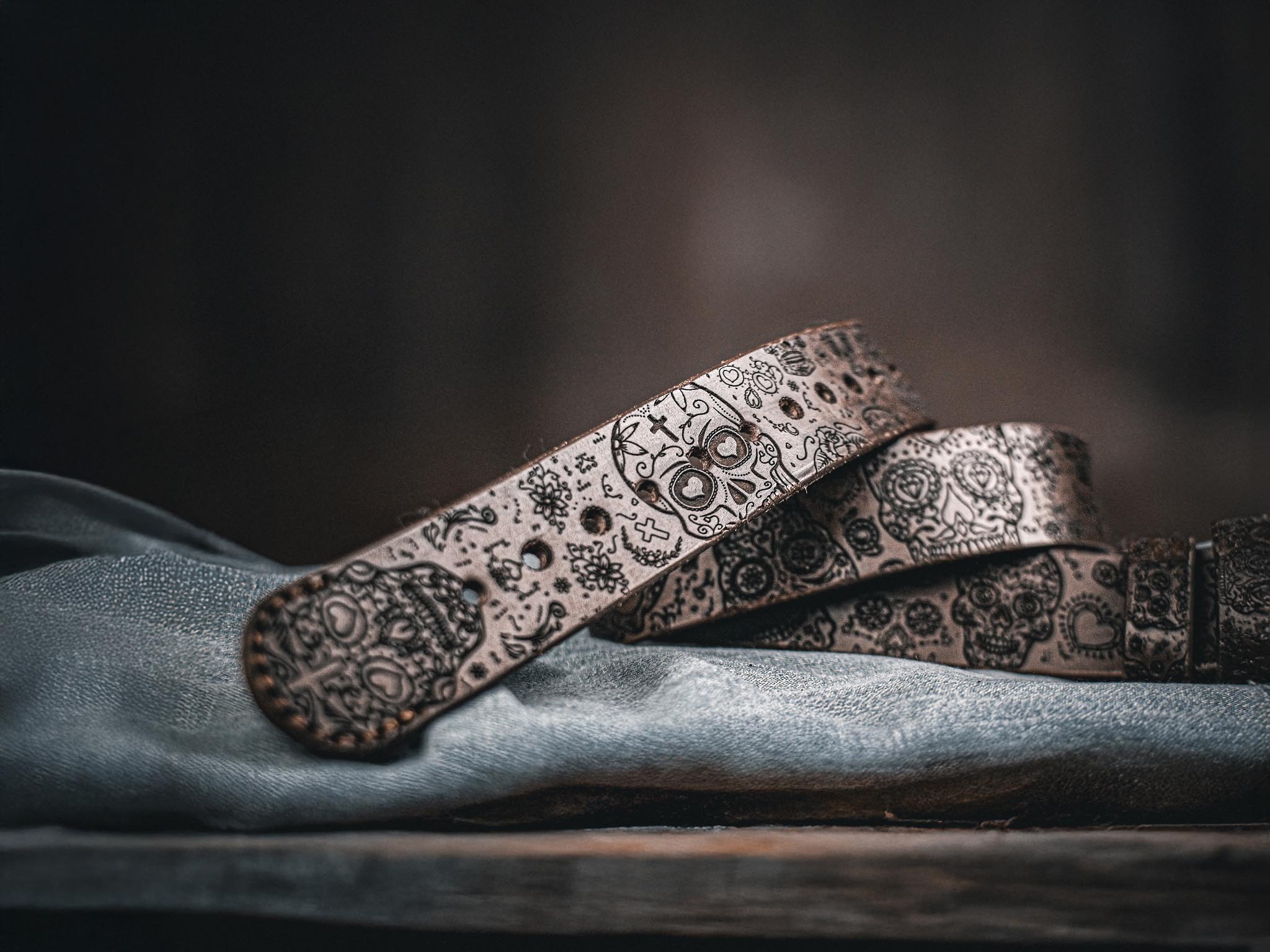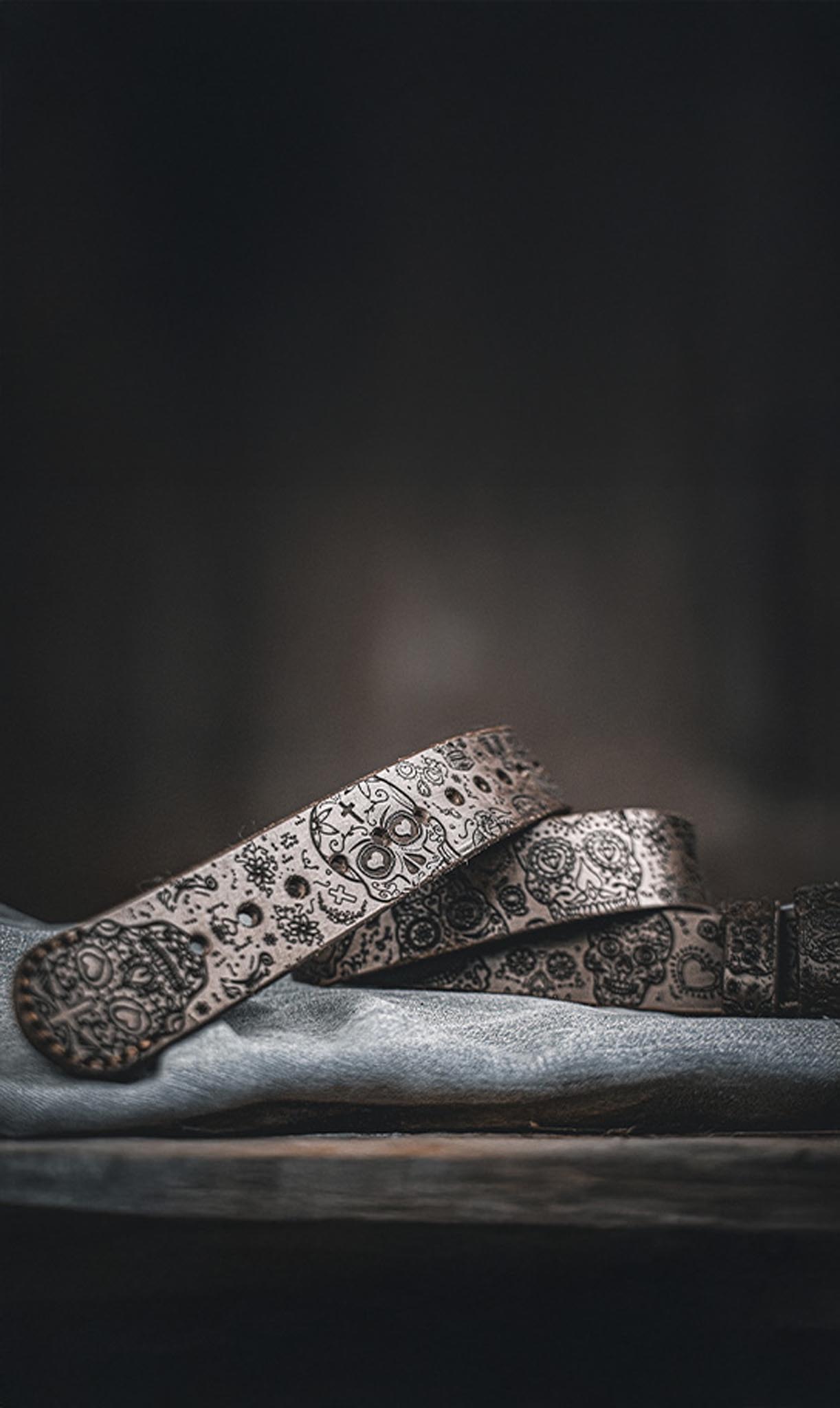Leather Belt with Engraving Inspired by Día de los Muertos
Author’s piece featuring Mexico’s cultural code
In stock


Leather Belt with Engraving Inspired by Día de los Muertos
Author’s piece featuring Mexico’s cultural code
In stock
This belt captures the visual language of Día de los Muertos. Through symbols of memory, life, and spiritual continuity, it bridges traditional culture and modern craftsmanship. The item unites function, form, and meaning.
This item was produced as part of a craft project focused on reinterpreting traditional visual codes from various cultures. The aesthetic of Mexico’s Día de los Muertos was selected as a reference - one of the few global rituals where death is integrated into daily life without repression or taboo. The primary goal was to create a functional object that carries the symbolism of memory, love, hope, and the life cycle.

The engraved composition includes sugar skulls, floral garlands, bones, candles, angel wings, crosses, and hearts. Each image serves a semantic function and is embedded within a coherent structure. The visual rhythm follows the logic of narrative repetition - similar to textiles or iconographic scrolls. While the belt may be perceived as a collectible item, it is designed for daily wear. The leather surface is hand-treated with wax, and the edges are polished. The buckle is custom-made in Italy.
The Concept and Thematic Basis
Work on the belt began after direct observation of the Día de los Muertos tradition. The author focused on the structure of the altars, rich in visual codes: skulls, candles, flowers, bones, hearts. These elements form a coherent system in which each symbol holds a fixed meaning and fulfills a cultural function.

The visual framework of the celebration appears as a complete and operational structure. Its compositional density and symbolic clarity served as the basis for developing a linear ornamental sequence, where motifs recur with variation and create rhythm. The engraved images are linked by theme and arranged in a progression - from remembrance to presence, from image to perception.
The belt was selected as the base due to its format: length, even surface, and the ability to support a continuous composition. Each symbol is positioned with purpose - not for decoration, but as a part of a visual statement. The work was carried out with precise selection of symbols, their proportions, relationships, and sequence. The objective was to produce a piece in which the ritual language of Día de los Muertos could be interpreted through craftsmanship - leather, tools, and form.
Materials and Technique
The main material is vegetable-tanned buffalo leather - dense, uniform in texture, minimally processed, and suitable for precision engraving. This surface ensures predictable results during ornament application and retains the sharp relief of the lines. The thickness is selected to meet the functional requirements: the piece is intended for wear while maintaining structural integrity over time.

Each belt is processed by hand. After cutting, the form goes through several stages: moistening, edge polishing, laser engraving, dyeing, and waxing. Environmentally safe, water-based dyes are used. For the final treatment, natural beeswax is applied - it protects the leather and gives it density, a matte finish, and resistance to external factors.
The buckle is custom-made by an Italian workshop specializing in brass and steel. The selected form is neutral, without decorative elements, allowing the engraving to remain the visual focal point. The fastening is secured with screws, allowing for buckle replacement without damaging the base. Structurally, the belt is designed for long-term use and preservation of its appearance under regular wear.
Symbolism and Composition
The belt's composition is structured as a continuous visual sequence. Each element is integrated into the overall rhythm and carries a specific semantic function. At the center is the image of the sugar skull, adorned with decorative patterns. In Mexican culture, it serves not as a marker of loss but as a sign of remembrance and joyful acknowledgment of the past’s significance.

Surrounding motifs emphasize the theme of connection. Marigold petals form garlands that establish rhythm and guide the eye along the ornament. In the Día de los Muertos tradition, these flowers function as points of navigation - both visual and ritual. Their inclusion defines the direction and highlights transitional nodes within the sequence.
Crosses, hearts, wings, bones, and candles are positioned as anchors of meaning. The cross reads as a vertical axis, a symbol of spatial linkage rather than theological intent. Hearts and wings introduce emotional and spiritual associations: feeling, protection, presence. Candles serve as markers of movement, sources of warmth and light. Bones hold the structure together - they support the integrity of the entire ornamental system. The composition follows a principle of stable repetition, with each symbol logically and visually fixed within the overall statement.
The Finished Object and Sensory Characteristics
The finished belt represents a complete work, in which technique, composition, and physical presence are unified. On the perceptual level, the object conveys a clear sense of weight, density, and structured surface. The leather offers resistance when bent, while retaining flexibility. The hand registers a smooth, taut texture - the wax finish adds subtle grip and a matte depth. Polished edges enhance the sense of cohesion - the object is perceived as a compressed yet complete form.

The laser-engraved ornament does not protrude but remains visually distinct. Under angled lighting, the relief becomes apparent without disrupting tactile smoothness. The symbols are not perceived in isolation but as parts of a continuous movement - the viewer and wearer follow the rhythm of the composition without interruption. The design contains no excess - each segment serves both a semantic and structural function.
Visually, the item presents itself with a defined character. It does not dominate the overall appearance, yet it introduces a clear accent - particularly when the wearer is still and the belt line becomes part of the visual axis. The belt’s aesthetic allows it to function in various contexts, from personal wear to collection display. The weight, texture, scent of leather, and coolness of the buckle all contribute to a cohesive, restrained, yet saturated sensory impression.
Context and Grounds for Selection
This belt is the result of thoughtful work with theme, material, and form. It combines symbolic density, craft precision, and a carefully structured design. It does not require explanation - it can be viewed, worn, gifted, or included in a collection. The piece is produced in limited quantity, and each unit is individually marked.

This object suits those who pay attention to the origin of things, value manual craftsmanship, and recognize nuance in detail. The belt functions not only as an accessory but also as a statement - defined, concise, and purposeful. It is suited for everyday wear while retaining its status as a collectible.
The item brings together cultural reference, tactile material presence, and a composition based on internal logic. Acquiring this belt means participating in a system of values where an object carries both function and idea. This piece is made for those who select objects that shape their environment, not simply occupy it.
Legacy of Mexico
Custom Engraved Leather Belt
$157.00
In stock
Our other posts






